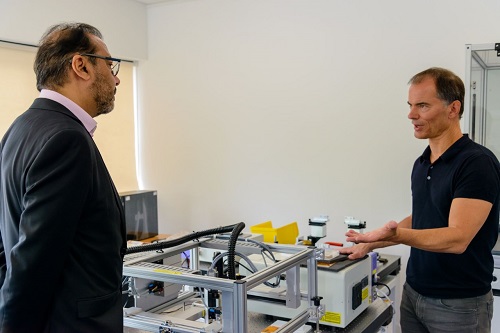The
following papers were presented at this year IRMMW 2021 conference in China.
Visualizing liquid transport through coated
pharmaceutical tablets using terahertz pulsed imaging
Dong, R., and J. A. Zeitler. "Visualizing
liquid transport through coated pharmaceutical tablets using terahertz pulsed
imaging." In 2021 46th International Conference
on Infrared, Millimeter and Terahertz Waves (IRMMW-THz),
pp. 1-2. IEEE.
… Above the flow cell, a commercial time-domain terahertz system (TeraPulse 4000, TeraView Ltd, Cambridge, UK) with a reflection probe
was used to acquire the terahertz time-domain waveforms while water
penetrated the tablet. The beam waist …
Terahertz waveform
selection of a pharmaceutical film coating process using a recurrent
network
Li, Xiaoran, Bryan M. Williams, Robert K. May,
Michael J. Evans, Shuncong Zhong, Lynn F. Gladden, Yaochun Shen, J. Axel
Zeitler, and Hungyen Lin. "Terahertz waveform selection of a pharmaceutical
film coating process using a recurrent network." In 2021 46th
International Conference on Infrared, Millimeter and Terahertz Waves (IRMMW-THz), pp. 1-2. IEEE.
Detecting
capacity of THz method applied to art painting
Smolyanskaya, Olga A., Sergey V. Sirro,
Alexander V. Minin, V. Yu Toropov, Olga V. Kravtsenyuk, Anastasiya A. Lykina,
Alessia Portieri et al. "Detecting capacity of THz method applied to art
painting." In 2021 46th International Conference on Infrared,
Millimeter and Terahertz Waves (IRMMW-THz), pp. 1-1. IEEE.
……The
image of paints on canvas was recorded using the TerPulse Lx (TeraView, UK)
system with a spectral range 0.06 THz – 6.00 THz …….
Terahertz Response of L-Serine at Low Temperatures
Sanders, T. J., J. L. Allen, J. Horvat, and R. A.
Lewis. "Terahertz Response of L-Serine at Low Temperatures." In 2021
46th International Conference on Infrared, Millimeter and Terahertz Waves
(IRMMW-THz), pp. 1-2. IEEE.
… At room temperature a terahertz time domain spectrometer
(THz-TDS; TeraView TeraPulse 4000) has been employed. Low
temperature measurements were taken on a Fourier transform spectrometer
(FTS; Bruker IFS 125HR), using a 125 µm mylar …
Quantifying water absorption of hygrothermally aged
epoxies with terahertz time-domain spectroscopy
Lin,
Hungyen, Benjamin P. Russell, Prince Bawuah, and J. Axel Zeitler.
"Quantifying water absorption of hygrothermally aged epoxies with
terahertz time-domain spectroscopy." In 2021
46th International Conference on Infrared, Millimeter and Terahertz Waves
(IRMMW-THz), pp. 1-2. IEEE.
… We performed transmission THz spectroscopy using
a commercial THz-TDS setup (Terapulse 4000, TeraView Ltd., Cambridge, UK).
Frequency-dependent optical constants can then be calculated from the
measurements and converted to …
Is there a terahertz absorption peak in frozen
aqueous solutions of DNA nucleosides?
Tao,
Yu Heng, Stuart I. Hodgetts, Alan R. Harvey, Stephen Moggach, and Vincent P.
Wallace. "Is there a terahertz absorption peak in frozen aqueous solutions
of DNA nucleosides?." In 2021 46th
International Conference on Infrared, Millimeter and Terahertz Waves
(IRMMW-THz), pp. 1-2. IEEE.
….Measurements were
conducted in a cryostat and measured in a commercial time-domain-spectroscopy
(TDS) spectrometer (Terapulse 4000, TeraView Ltd, Cambridge, UK) in
transmission mode. The measurements were made within a chamber purged with
nitrogen, and the reference was taken with no sample present……
Enhanced THz signal via Au encapsulated in hydrogel
gel for non-enzymatic glucose sensing
Zhao,
Jingjing, Shaohua Lu, Shuting Fan, and Zhengfang Qian. "Enhanced THz
signal via Au encapsulated in hydrogel gel for non-enzymatic glucose
sensing." In 2021 46th International Conference
on Infrared, Millimeter and Terahertz Waves (IRMMW-THz),
pp. 1-2. IEEE.
…
A commercial THz-TDS system, TeraPulse 4000 from TeraView Ltd.,
was used to measure the absorption of the samples. …
Phase diagram method for efficient THz images
reconstructing
Nastasiu,
D., M. Bernier, C. Ioana, C. Tréhoult, L. Lyannaz, and F. Garet. "Phase
diagram method for efficient THz images reconstructing." In 2021
46th International Conference on Infrared, Millimeter and Terahertz Waves
(IRMMW-THz), pp. 1-2. IEEE.
… Experimentally, we used a commercial THz-TDS spectrometer (TeraPulse from Teraview)
to perform 10 000 pixels’ images (3 cm x 3 cm – step 300 µm) of geometric
patterns with different sizes, printed with conductive ink on dielectric
and …
Terahertz Biosensors with high sensitivity for the
recognition of neurotransmitter
Lu,
Shaohua, Di Zhou, Jingjing Zhao, Zhengfang Qian, and Shuting Fan.
"Terahertz Biosensors with high sensitivity for the recognition of
neurotransmitter." In 2021 46th
International Conference on Infrared, Millimeter and Terahertz Waves
(IRMMW-THz), pp. 1-2. IEEE.
.... reflection module of a commercial terahertz time domain spectroscopy
system (TeraPulse …
THz and IR spectroscopy of H2O@C60 endofullerene
Melentev,
Alexander V., Sergey S. Zhukov, Vasileios Balos, Gabriela Hoffman, Shamim Alom,
Mikhail Belyanchikov, Elena Zhukova et al. "THz and IR spectroscopy of H 2
O@ C 60 endofullerene." In 2021 46th International
Conference on Infrared, Millimeter and Terahertz Waves (IRMMW-THz),
pp. 1-2. IEEE.
…
Spectroscopic transmission measurements were carried out in a
wide temperature range of 6–300 K using time-domain terahertz
spectrometer TeraView TPS Spectra 3000....
Assessing Changes in Human Skin Using in vivo
Terahertz Measurements
Lindley-Hatcher,
Hannah, A. I. Hernandez-Serrano, Jiarui Wang, Juan Cebrian, Joseph Hardwicke,
and Emma Pickwell-MacPherson. "Assessing Changes in Human Skin Using in
vivo Terahertz Measurements." In 2021 46th
International Conference on Infrared, Millimeter and Terahertz Waves
(IRMMW-THz), pp. 1-2. IEEE.
… A TeraPulse 4000 system
from TeraView Ltd was used to perform in vivo
point scans of human skin in a reflection geometry with the skin in
contact with a quartz window for the duration of the measurement, as shown
in Fig. 1. a). .....
For more information about TeraView click here










